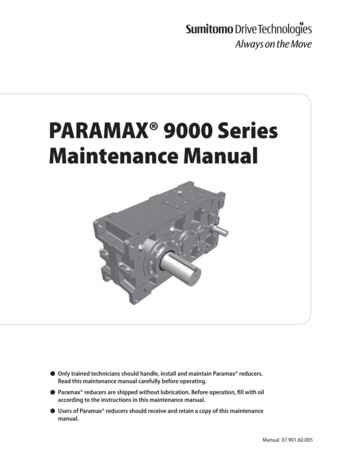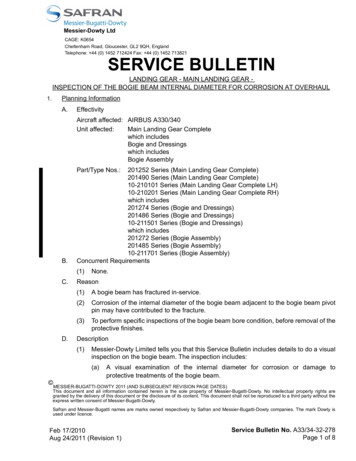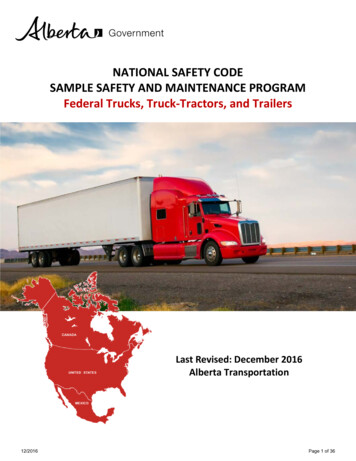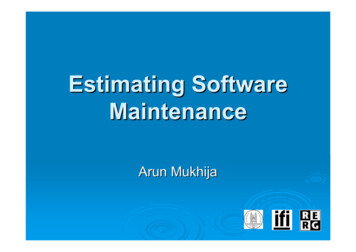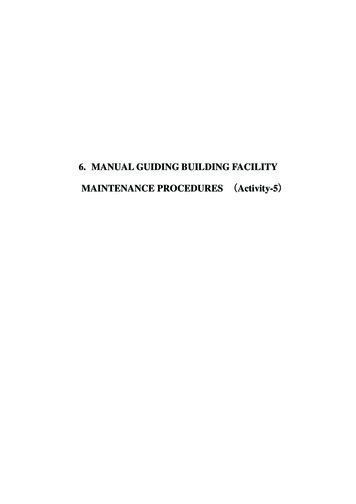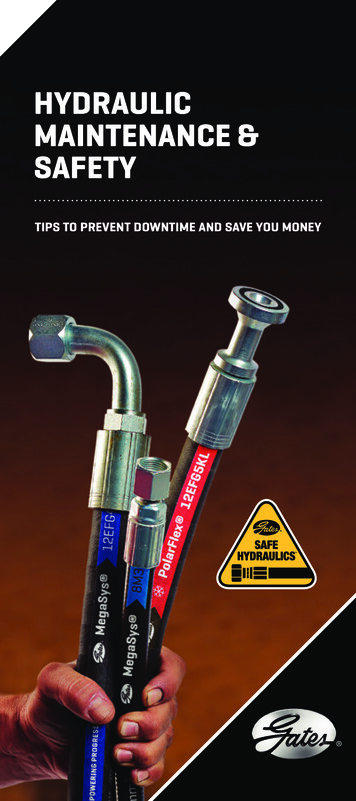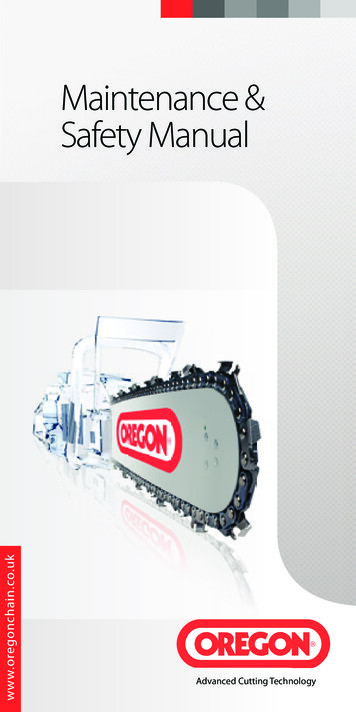
Transcription
www.oregonchain.co.ukMaintenance &Safety ManualAdvanced Cutting Technology
IntroductionIntroductionYour chainsaw is only as good as your chain, guide bar, and sprocket.They function as a team while doing the actual work of cutting wood and,therefore, must be maintained as a team.A properly maintained chain, bar, and sprocket will provide excellentcutting performance. An improperly maintained chain will causedamage to the bar and sprocket, will cut poorly, and will create potentialsafety hazards.This manual addresses the maintenance of only OREGON manufacturedchains, bars, and sprockets. For information on maintenance andoperation of your saw, refer to your saw’s operator’s manual or contactyour local chainsaw dealer.2.
IntroductionIMPORTANT SAFETY MESSAGESAFETY SYMBOLThis safety symbol is used to highlight safety messages. When you seethis symbol, read and follow the safety message to avoid severe personalinjury.WARNINGAll cutting chain can kick back, which can lead to dangerous loss ofcontrol of the chainsaw and result in serious injury to the saw operator orby standers. Follow all instructions in your chainsaw operator’s manualand in this booklet for proper use and maintenance of your saw’s cuttingchain, guide bar, and sprocket.GUARD AGAINST CHAINSAW KICKBACK Know your personal level of chainsaw experience. Know your cutting chain.If you do not have experience and specialized training for dealing withchainsaw kickback, then OREGON urges you to use only low-kickbacksaw chains.WHAT IS KICKBACK?Kickback is the violent backward and/or upward motion of the chainsawguide bar occurring when the chain near the nose or tip of the guide barcontacts any object, such as another log or branch, or when the woodcloses in and pinches the saw chain in the cut.TO HELP AVOID INJURYKickback Awareness➊ Be alert at all times to guard against a possible kickback reaction. Alwaysbe aware of the position of yourbar’s nose.➋ Different models of cuttingchain are available for mostcutting tasks.Use thechain, suitable for yourtype of cutting, with thePotential Kickback Situationlowest kickback potential.➌ Narrow-nose bars such as OREGON Double Guard bars arerecommended for maximum kickback safety.3.IntroductionCHAINSAW SAFETY
IntroductionIntroductionCHAINSAW SAFETYCLOTHING AND PROTECTIVE EQUIPMENTWear protective gloves toprevent slippage and toprotect hands.Wear chainsaw protectiveboots or safety boots andgaiters to protect feet.Wear hard hat to protecthead.Wear ear protection toprotect ears.Wear safety goggles orface shield to protect eyes.Wear protective trousersor leggings to protect legsNOTE: Dress properly - do not wear clothing that is too tight or too loose.MAKE PROPER WORK PRACTICES A HABIT Use only a right-hand grip to hold your saw (right hand on the trigger,left hand on the front handle). Keep your left arm straight for better control. Hold saw firmly with both hands. Keep thumb firmly locked aroundfront handle. Stand to the side of the chainsaw, never behind it. Run engine at full throttle. Use low-kickback saw chain and a reduced-kickback guide bar. Keep the chainsaw, cutting chain, guide bar and sprocket properlymaintained. Stand with feet well braced and your body balanced. Cut only wood with your chainsaw. Do not cut any other material.CAUTIONKeep yourself clear of the work. Before cutting : Calculate how the object being cut will fall. Determine if the saw may be thrown unexpectedly by the movementof the cut material. Position yourself to avoid injury. Never cut above shoulder level. Never cut while in a tree, or while on a ladder. Keep others away from the cutting area.Do not allow others to hold wood during cutting. 4.
ContentsCHAINChain Terms . 2Chain Pitch . 2Chain Gauge . 2Parts of a Cutter. 2Cutter Sequence . 2Parts of a Saw Chain . 3Maintenance Terms . 3Chain maintenance tools . 4Chain identification chart . 5-7GUIDE BARSGuide bar terms .55Guide bar maintenancetools .55Guide bar maintenance . 56-57How to replacePower Match noses . 58-59Pro-Lite nosessprockets. 60-61Guide bartroubleshooting . 62-64Chain drive-link numberidentification . 8DRIVE SPROCKETSSprocket terms, tools,and installation .65Chain letter identification . 9Sprocket maintenance . 66-67Four basic rules . 10-11Sprockettroubleshooting . 68-69How to maintain the chain .12How to tension chain . 13-15How to lubricate chain .15How to set depthgauges . 16-17USEFUL INFORMATIONUseful information . 70-71How to sharpen cutters . 18-19How to install chain parts 20-21How to break out rivets . 22-23How to run-in a new chain .24End-user symbols.25Filing specifications . 26-47Chain troubleshooting . 48-54CONTENTS1.ContentsINTRODUCTIONIntroduction .Chainsaw safety .
Saw ChainsSaw ChainsOREGON CHAIN TERMSCHAIN PITCHChain Pitch is the distance between any three consecutive rivets, dividedby two. OREGON chain pitches are:1/4", .325", 3/8", .404" and 3/4".CHAIN GAUGEChain gauge is the drive link’s thickness where it fits into the guide-bargroove. The industry standard for chain gauges are:.043" (1.1mm), .050" (1.3mm), .058" (1.5mm), .063" (1.6mm)OREGON chain gauges of .080" (2mm) and .122" (3.1mm) are usedfor Harvester applications.THE PARTS OF A CUTTERTopplateCutting cornerRivetHoleHeelSide PlateGulletDepthGaugeToeCHAIN CUTTER-SEQUENCE TERMSStandardIntroductionSemi-SkipSkip2.2.
Saw ChainsOREGON CHAIN TERMSNOTE: Highlighted parts below indicate kickback-reducing “bumperlink" features: bumper tie strap, bumper drive link, and ramped depthgauge.Drive LinkPreset Tie StrapPreset Bumper Tie StrapLeft-hand CutterBumper Tie StrapRampedDepthGaugeRight-hand CutterRamped Depth GaugeTie StrapLeft-hand CutterBumper Drive LinkDepth GaugeRight-hand CutterTie StrapDepth GaugeCUTTER MAINTENANCE TERMSDepth-gauge SettingTop-plate Filing AngleTop-plate Cutting AngleFile-guide Angle3.Saw ChainsTHE PARTS OF A SAW CHAIN
Saw ChainsOREGON CHAIN-MAINTENANCE TOOLSSaw ChainsFILING TOOLS➊ASSEMBLED FILE GUIDE➌ROUND FILE➏ BAR-MOUNTEDFILING GUIDE➋➍ FLAT FILE➐SHARPENING KIT➎ DEPTH-GAUGE TOOL➑ FILING VISEFILE HANDLEGRINDERS➊➋SURE SHARP 12-VOLT GRINDERBENCH-MODELCHAIN GRINDER➌ MINI GRINDER➍ GRINDING WHEELSCHAIN-REPAIR TOOLSIntroduction➊4.4.CHAIN BREAKER➋RIVET SPINNER➌ POCKET-CHAINBREAKER
Saw ChainsOREGON CHAINPARTFILINGSPEC’SOREGON CHAINTYPECHAIN GAUGEIN.MMCUTTER TYPEENDSIDEVIEWVIEWCUTTERSEQUENCEMICRO CHISEL STANDARDKICKBACKREDUCINGFEATURES(IF ANY)*1/4" PITCH CHAIN25APPage26MICROCHISEL 050"1.3.325" PITCH CHAINS20BPX21BPX22BPXPageMICROCHISEL 050"058"063"1.31.51.6MICRO CHISEL .51.6CHISELSTANDARDM21LPX Page MULTICUT 058"063"M22LPX1.51.6CHISELSTANDARDMICRO CHISEL STANDARDMICRO CHISEL STANDARD27283195VPX95RPageMICROLITE 050"1.3PageRIPPINGCHAIN050"1.33043KICKBACK REDUCING FEATURES➊BUMPERDRIVE LINK➋BUMPERTIE STRAP➌RAMPEDDEPTH GAUGE➍LOW-PROFILERAMPEDDEPTH GAUGE5.Saw ChainsCHAIN IDENTIFICATION
Saw ChainsSaw ChainsCHAIN IDENTIFICATIONOREGON CHAINPARTFILINGSPEC’SOREGON CHAINTYPECHAIN GAUGEIN.MMCUTTER TYPEENDSIDEVIEWVIEWCUTTERSEQUENCE3/8" PITCH SUPERGUARD 1.51.6CHISEL(LP)STANDARDM73LPX Page MULTICUT LPXPage SUPER Page39RIPPINGCHAIN050"058"063"1.31.51.6MICROLITE AMFER-CHISEL STANDARDCHAMFER-CHISEL STANDARD40LowvibrationXTRAGUARD 050"1.3-POWERSHARP 050"1.3PageRIPPINGCHAIN050"1.3MULTICUT R-CHISEL STANDARDCHAMFER-CHISEL S(IF ANY)*
Saw ChainsOREGON CHAINPARTFILINGSPEC’SOREGON CHAINTYPECHAIN GAUGEIN.MMCUTTER EATURES(IF ANY)*MICRO CHISEL STANDARDMICRO CHISEL STANDARD P ONLYMICRO CHISEL (R)STANDARD.404" PITCH CHAINS16H18HXPage2627, CHISEL 058"063"1.51.6PageRIPPINGCHAIN063"1.6MICROBIT 063"1.6SUPER058"GUARD 063"1.51.64142Page44Page45CHIPPERSTANDARD CP ONLYCHISELSTANDARDSEMI-CHISELSTANDARD3/4" PITCH CHAINS11HPage46SEMICHISEL122"3.1KICKBACK REDUCING FEATURES➊BUMPERDRIVE LINK➋BUMPERTIE STRAP➌RAMPEDDEPTH GAUGE➍LOW-PROFILERAMPEDDEPTH GAUGE7.Saw ChainsCHAIN IDENTIFICATION
Saw ChainsCHAIN DRIVE-LINK NUMBER IDENTIFICATIONIntroductionSaw ChainsNearly all OREGON chains are named by a part number made up of anumber (see below), followed by one or two letters (see page 9).OREGON Part-number Examples: 18 HX, 72LPX, 91VGThe Numbers: 18 HX, 72 LPX, 91 VGThe numbers are stamped on the chain’s drive links and indicate thephysical size of the chain (pitch and 61.31.51.61.51.61.31.51.61.11.31.3
Saw ChainsThe letters: 18 HX , 72 LPX , 91 VGThe letters represent cutter type and sequence, safety features, or otherphysical traits of the chain.MSpecially built chain withround-ground chisel cutters(M73, 75LPX, M21,22LPX)and Bumper Drive Link orchamfer-chisel cutter (M91VX)and ramped depth gauge foreffective cutting in extremelydirty or abrasive conditionsRRipping Chain, Chamfer-chisel(91R) or Micro-chisel(95R,27R) Cutter,Standard SequenceRARipping Chain, Micro-chiselCutter, Skip SequenceRDModified for Harvesterapplications, Micro Chisel or Semi-chisel cutterswith Standard SequenceRipping chain with semichisel cutters and standardsequenceSGRound-ground chisel cutterswith standard sequence (.404"58L & 59L)Low vibration chamfer-chiselcutters, ramped depth gauge,bumper tie strap, standardsequence, narrow kerf design.VGLow-vibration Chamfer-chiselcutter, ramped depth gauge,bumper tie strap, standardsequenceVPXLow-vibration Micro Chisel cutter, ramped depth gauge,bumper drive link, narrow-kerfdesign (95VPX only)VXLow-vibration Chamfer-chiselcutters, ramped depth gauge,standard sequenceVXLLow-vibration Semi-chiselcutters with long top plate,ramped depth gauge,standard sequenceACChipper Cutter,Standard SequenceAPMicro Chisel Cutter,Bumper Drive Link,Standard SequenceBCChipper cutter with standardsequence (11BC only)BPXLow vibration Micro Chisel Cutter, Bumper Drive Link,Standard SequenceDXSemi-chisel Cutter, StandardSequenceDPX Semi-chisel Cutter, BumperDrive Link, StandardSequenceHLLGX Round-ground ChiselCutter, Ramped DepthGauge, StandardSequence.LPXLow vibration Round-groundChisel Cutter, Bumper DriveLink, Standard SequenceLXPower Sharp Chain,Ramped Depth Gauge,Bumper Drive Link,Standard Sequence(no hand maintenancerequired)9.Saw ChainsCHAIN LETTER IDENTIFICATION
Saw ChainsSaw ChainsTHE FOUR BASIC SAW-CHAIN RULESATTENTION CHAINSAW USERS:OREGON urges you to become familiar with the four basic saw-chainrules. Users who know and follow these rules can count on superiorperformance from their chain, bar, and sprocket, - and reduce safetyhazards at the same time.RULE NUMBER 1Your chain must be correctly tensioned.More chain and bar problems are caused by incorrect chain tensionthan by any other single factor. See pages13 and 14 on how to tensionyour chain.IntroductionRULE NUMBER 2Your chain must be well lubricatedA constant supply of oil to your saw’s bar, chain and sprocket is vital.Without it, excessive friction, wear, and damage will occur.See page 15 for instructions on how to lubricate your chain.10.10.
Saw ChainsTHE FOUR BASIC SAW-CHAIN RULESSaw ChainsRULE NUMBER 3Your chain’s depth gauges must be set correctlyDepth-gauge setting and depth-gauge shape are critical to performanceand safety. See pages 16-17 for instructions on how to set your chain’sdepth gauges.RULE NUMBER 4Your chain must be sharpWhen your chain is sharp, it does the work. When it’s not, you do the work- and your cutting attachments will wear more rapidly. See pages 18 and 19for instructions on how to sharpen your chain. See pages 26 to 47 to findmaintenance specifications for each OREGON chain type.11.
Saw ChainsSaw ChainsHOW TO MAINTAIN CHAINATTENTION: DEALERS, CHAINSAW USERS, AND ANYONE WHOSERVICES SAW CHAIN - IMPORTANT SAFETY INFORMATION.OREGON urges you to become familiar with proper chain-maintenancetechniques, and the possible dangers which can result if chain is notproperly maintained.WARNINGFailure to follow the instructions below can result in severeinjury to the saw operator, bystanders, or the personperforming maintenance.Always turn off your saw’s engine before handling the chain,guide bar or sprocket.Any one of the following conditions can increase a chain’spotential kickback energy, increase the risk of a chain throwingitself off the bar, or increase the risk of other hazards associatedwith chainsaw use.1. Incorrect sharpening of chain angles.2. Dull chain.3. Alteration of kickback-reducing chain features.4. Excessive chain depth-gauge settings.5. Incorrect chain depth-gauge shapes.6. Loose chain tension.7. Incorrectly installed chain parts.8. Loose rivets, or cracks or breaks in any chain component.IntroductionWhen performing maintenance on saw chain, follow all instructionson pages 12 through 54. Doing so can minimize the risk of injury.12.12.
Saw ChainsSaw ChainsHOW TO TENSION YOUR CHAIN WITHOUT INTENZ Read the warnings on page 12.NOTE: Always wear protective gloves.➊Turn the engine off.NOTE: Never tension your chain right after cutting. Chain tensionedwhile hot can cool and contract, causing tension to be much too tight.Let chain cool first.➋Loosen bar-mounting nuts on the side of your saw.➌ Pull the bar nose up, and keep it up as you adjusttension.➍ Adjust tension as follows:If you have a solid-nose bar Turn your saw’s tension-adjustment screw until the bottoms of thelowest tie straps and cutters come up and just touch the bottom ofthe bar rail.13.
Saw ChainsSaw ChainsHOW TO TENSION YOUR CHAIN WITHOUT INTENZ If you have a sprocket-nose bar Tension must be tighter than on a solid-nose bar.Turn your saw’stension-adjustment screw until the bottoms of the lowest tie strapsand cutters come up and solidly contact the bottom of the bar rail.➎ With either type of bar, hold the nose up and tighten your saw’s rearbar-mounting nut first, then tighten the front nut.➏ Pullthe chain by hand along the top of the bar several times,from the engine to the bar’s tip. Chain should feel snug but still pullfreely.NOTE: If you have a sprocket-nose bar you should now perform the snaptest. Grasp the chain along the bottom of the bar, pull down, and let go.Chain should snap back to its original position, solidly contacting thebottom of the bar.➐ CheckIntroductiontension often during operation, especially during the firsthalf-hour. If chain loosens: stop, let chain cool, and readjust tension.14.14.
Saw ChainsSaw ChainsHOW TO TENSION YOUR CHAIN WITH INTENZ ➊➋Turn the engine off.Loosen the bar mountingnuts on the side of the saw.➌➍Insert a combination tool blade in the Intenz slot of the guide bar.Turn the combination tool to move the guide bar forwards, awayfrom the saw as far as possible.➎Tighten the back bar mounting nut, then tighten the front nutHOW TO LUBRICATE YOUR CHAIN➊Keep your saw’s chain-oiling system filled with clean bar-and-chainoil.➋➌Never put used oil, or old motor oil in your saw or on your chain.➍Be sure your chain, bar, and sprocket are always receiving oil fromthe saw during operation.Fill your oil reservoir each time you fill your gas tank.15.
Saw ChainsSaw ChainsHOW TO SET DEPTH GAUGESRead the warnings on page 12.NOTE: On saw depth-gauge setting requires proper chain tension, as shownon pages 13-14,prior to filing. Pages 26 through 47 show the correct depth-gauge setting and thepart number of the correct depth-gauge tool for each of the differentOREGON chain types. Find the page (26-47), which gives the correct filing specificationsfor your OREGON chain type. To do so, use the Chain identificationchart on pages 5, 6 and 7. If unsure of your OREGON chain’s type, or part number, ask yourOREGON saw chain dealer. Most OREGON chains have a number stamped on each depthgauge indicating the correct depth-gauge setting.EXAMPLE:.025" (0.64mm).025" (0.64mm) Depth-gauge SettingUse a depth-gauge tool with the correct built-in setting for yourchain and check your depth gauges every 3 or 4 sharpenings.➋Place the tool on top of your chain so one depth gauge protrudesthrough the slot in the tool.➌If the depth gauge extends above the slot, file the depth gaugedown level with the top of the tool using a flat file.Never file the depth gauge down enough to exceed the depth-gaugesetting specified in this manual for your OREGON chain.Introduction➊16.16.
Saw ChainsSaw ChainsHOW TO SET DEPTH GAUGESNOTE: Do not file or alter the tops of kickback-reducing bumper tiestraps or bumper drive links.➍File from the inside of the cutter to the outsideoutsideinside➎After lowering, always file off the front corner of each depth gaugeparallel to its original rounded or ramped shape.NOTE: On many chains, it may be helpful to tip the depth gauge tool onend and place it in front of the working corner in order to protectthe cutting surfaces when re-shaping depth gauges.17.
Saw ChainsSaw ChainsHOW TO SHARPEN CUTTERSRead the warnings on page 12.NOTE: On-saw sharpening requires proper chain tension. Pages 26 through 47 show the correct maintenance specificationsand the correct maintenance-tool part numbers for each of theOREGON chain types. Find the correct filing specifications for your OREGON chain type. If unsure of your OREGON chain’s type, part number or filingspecification, ask your OREGON saw chain dealer. Check and adjust depth gauges.ROUND-FILE CUTTER SHARPENING➊Be sure 1/5th, or 20%, of the file’s diameter is always held abovethe cutter’s top plate. Using the correct file guide is the easiest wayto hold the file in this position. 1/5th or 20%above top plate➋Keep the correct Top-plate Filing Angle line on your file guideparallel with your chain.IntroductionDirectionof strokeFile holder18.18.
Saw Chains➌Sharpen cutters on one side of the chain first. File from the inside ofeach cutter to the outside. Then turn your saw around and repeatthe process for cutters on the other side of the chain.outsideinside➍If damage is present on the chrome surface of top plates or sideplates, file back until such damage is removed.➎Keep all cutter lengths equal.A➏A BBRe-check depth gauges. If re-setting of the depth gauges is necessary,follow instructions on pages 16 and 17.NOTE: Do not file or alter the tops of kickback-reducing bumpertie straps or bumper drive links.19.Saw ChainsHOW TO SHARPEN CUTTERS
Saw ChainsSaw ChainsHOW TO INSTALL NEW CHAIN PARTSRead the warnings on page 12.NOTE: Use only OREGON parts to repair OREGON chain. And only useparts which are the correct size and type for your chain.Remove rivets, and parts to be replaced, as shown under “How toBreak Out Rivets," pages 22 to 23. Never reassemble a chain withold preset tie straps - always use new preset tie straps.➋If needed, file off bottom of new parts to match existing worn parts.File new cutters back to match worn cutters. Do not file the tops ofkickback-reducing bumper tie straps or bumper drive links.➌Place the preset tie strap on a flat outersurface of a chain-breaker anvil. Besure the rivets are pointing up.Introduction➊20.
Saw ChainsHOW TO INSTALL NEW CHAIN PARTSAssemble chain to the preset tie strap.➎Assemble tie strap with brandmark orLubrilink contour face up, and the notchtoward the drive-link tangs. Assemble bumper tie strap in the correct direction, with thenotch toward the drive-link tangs.➏Be sure parts are assembled in the correct location, sequence anddirection. Check the illustrations on pages 2 and 3. If unsure, ask yourOREGON dealer.➐To form rivet heads, use an OREGON rivet spinner. Follow the instructions packaged with the rivet spinner.Saw Chains➍CAUTION:Rivet heads must be snug and secure while still allowing all joinedparts to move freely. Rapid wear leading to possible chain breakageand personal injury can be caused by rivet heads that are either tootight, or too loose.NOTE: New rivet heads may be smaller and shaped differently thanfactory-spun heads.21.
Saw ChainsHOW TO BREAK OUT RIVETSSaw ChainsNOTE: Always wear approved safety accessories for hands andface when breaking out rivets.➊Select proper anvil slot number on chainbreaker anvil which matches the drive-linknumber on the chain to be broken (seeChain Drive-link-number Chart on the nextpage).➋Insert chain portion for breaking into theproper slot of the chain anvil and pushchain forward until bottom tie strap is flushwith the far side of slot. (Drive link is thensupported on both sides of slot.)➌Position rivet head directly under punch.Pull handle down if using a bench chainbreaker, or hammer out rivet if using ahandheld punch. Do not use excessiveforce.IntroductionNOTE: Important-when breaking chain at cutter, make sure cutter is inup position.22.22.
Saw ChainsREMOVING RIVETS FROM BROKEN DRIVE LINKS➊When removing rivets from broken drive links, hold the two brokensegments together in their original (unbroken) positions as youtighten the chain link in the adjustable anvil.➋See steps 1-3 from “How to break out rivets" on the previous page.CHAIN DRIVE-LINK-NUMBER CHARTANVIL SLOTNUMBER1/4DRIVE-LINK25NUMBER.325 90/91 w ChainsHOW TO BREAK OUT RIVETS
Saw ChainsSaw ChainsHOW TO RUN-IN A NEW CHAINThe life of your new chain can be extended by taking these few simple stepsbefore using it.Soak the chain overnight to allow oil topenetrate all chain components.➋Never run any chain on a worn drive sprocket, especially a newchain. Replace drive sprocket systems after every two chains, orsooner.➌Run new chain at half throttle for several minutes before doing anycutting in order to allow oil to reach all parts of the bar and chain. Letsprocket, bar, and chain warm up fully.➍Stop, check chain tension, let chain cool, and adjust tension oftenduring operation, as shown on pages 13 and 15.➎Keep the first several cuts light.Keep extra oil on the bar and chain during these first cuts,and do not apply heavy pressure.Introduction➊24.24.
Saw ChainsCHAINSAW SAFETYEach of these four symbols represents a large category of saw-chainusers. OREGON chains are listed under one or more of these symbols,generally indicating the type of user for whom the chain isintended.PROFESSIONAL CHAINSAW USERS Big-timber loggers Pulpwood loggers Forest firefightersCOMMERCIAL CHAINSAW USERS Arborists Orchardists Utility and construction workers Tree surgeons Farmers Commercial thinners Commercial firewood cutters LandscapersCASUAL CHAINSAW USERS Homeowners Occasional firewood cutters Campers HuntersMECHANICAL HARVESTER USERS For use on mechanical timber- harvesting equipment Do not use harvester attachments on hand-held saws.NOTE: Harvester chains are listed in this manual for reference. For moreinformation on other harvester products, see the OREGON Harvestercatalogue and technical data.25.Saw ChainsTHE FOUR OREGON END-USER SYMBOLS
MICRO CHISEL 1/4"OREGON MICRO CHISEL Saw ChainsKickbackReducingFeaturesEnd ViewCHAIN TYPE25AP.050"UseGAUGE(1.3mm)FILING➊ DEPTH-GAUGE➋ TOP-PLATE CUTTING ANGLE:➌ TOP-PLATE FILING➍ FILE-GUIDESETTING:ANGLE:ANGLETOOLS FOR FILINGIntroductionPART N .7050416265275301221190405ToeDESCRIPTION5/32" (4.0mm) Round File5/32" (4.0mm) Assembled File Guide.025" (0.64mm) Depth-gauge ToolDepth-gauge File (flat)Sharpening kitChain on this page is intended for use with saws up to 2.3 cu. in.displacement (38cc), and bars up to 16 in. length (41 cm).26.26.
MICRO CHISEL 325''OREGON MICRO CHISEL End ViewCHAIN TYPE20BPX21BPX22BPXUseSaw (1.3mm)(1.5mm)(1.6mm)FILING➊ DEPTH-GAUGE➋ TOP-PLATE CUTTING ANGLE:➌ TOP-PLATE FILING➍ FILE-GUIDESETTING:ANGLE:ANGLETOOLS FOR FILINGPART N .7050318228275301221190407ToeDESCRIPTION3/16" (4.8mm) Round File3/16" (4.8mm) Assembled File Guide.025" (0.64mm) Depth-gauge ToolDepth-gauge File (flat)Sharpening kit27.noitcudortnIChain on this page is intended for use with saws up to 3.5 cu. in.displacement (58cc), and bars up to 20 in. length (50 cm).27.
SUPER 20 .325"OREGON CHISELSaw ChainsKickbackReducingFeaturesEnd ViewCHAIN 1.5mm)(1.6mm)FILING➊ DEPTH-GAUGE➋ TOP-PLATE CUTTING ANGLE:➌ TOP-PLATE FILING➍ FILE-GUIDESETTING:ANGLE:ANGLETOOLS FOR FILINGIntroductionPART N .7050318228275301221190407ToeDESCRIPTION3/16" (4.8mm) Round File3/16" (4.8mm) Assembled File Guide.025" (0.64mm) Depth-gauge ToolDepth-gauge File (flat)Sharpening kitChain on this page is intended for use with saws up to 3.5 cu. in.displacement (58cc), and bars up to 20 in. length (50 cm).28.28.
LOW PROFILE 3/8"OREGON SEMI CHISELEnd ViewCHAIN TYPE91VXLUseSaw ING➊ DEPTH-GAUGE➋ TOP-PLATE CUTTING ANGLE:➌ TOP-PLATE FILING➍ FILE-GUIDESETTING:ANGLE:ANGLETOOLS FOR FILINGPART N .7050416265275301221190405ToeDESCRIPTION5/32" (4.0mm) Round File5/32" (4.0mm) Assembled File Guide.025" (0.64mm) Depth-gauge ToolDepth-gauge File (flat)Sharpening kit29.noitcudortnIChain on this page is intended for use with saws up to 3.8 cu. in.displacement (62cc), and bars up to 20 in. length (50 cm).29.
MICRO-LITETM .325"OREGON MICRO CHISEL Saw ChainsKickbackReducingFeaturesEnd ViewCHAIN TYPE95VPX.050"UseGAUGE(1.3mm)FILING➊ DEPTH-GAUGE➋ TOP-PLATE CUTTING ANGLE:➌ TOP-PLATE FILING➍ FILE-GUIDESETTING:ANGLE:ANGLETOOLS FOR FILINGIntroductionPART N .7050318228275301221190407ToeDESCRIPTION3/16" (4.8mm) Round File3/16" (4.8mm) Assembled File Guide.025" (0.64mm) Depth-gauge ToolDepth-gauge File (flat)Sharpening kitChain on this page is intended for use with saws up to 2.8 cu. in.displacement (45cc), and bars up to 18 in. length (45 cm).30.30.
MULTICUT .325"OREGON CHISELEnd ViewCHAIN TYPEM21LPXM22LPX.058".063"UseSaw ILING➊ DEPTH-GAUGE➋ TOP-PLATE CUTTING ANGLE:➌ TOP-PLATE FILING➍ FILE-GUIDESETTING:ANGLE:ANGLETOOLS FOR FILINGPART N .7050318228275301221190407ToeDESCRIPTION3/16" (4.8mm) Round File3/16" (4.8mm) Assembled File Guide.025" (0.64mm) Depth-gauge ToolDepth-gauge File (flat)Sharpening kit31.noitcudortnIChain on this page is intended for use with saws up to 3.5 cu. in.displacement (58cc), and bars up to 20 in. length (50 cm).31.
MULTICUT 3/8"OREGON CHISELSaw ChainsKickbackReducingFeaturesEnd ViewCHAIN LING➊ DEPTH-GAUGE➋ TOP-PLATE CUTTING ANGLE:➌ TOP-PLATE FILING➍ FILE-GUIDESETTING:ANGLE:ANGLETOOLS FOR FILINGIntroductionPART N .7050213252275301221190404ToeDESCRIPTION7/32" (5.5mm) Round File7/32" (5.5mm) Assembled File Guide.025" (0.64mm) Depth-gauge ToolDepth-gauge File (flat)Sharpening kitUp to three times the stay sharp of conventional chain. For use withsaws up to 6.0 cu in displacement (98cc) and bars up to 36 in length(91 cm).32.32.
S-70 3/8"OREGON SEMI CHISELEnd ViewUseSaw ChainsKickbackReducingFeaturesOnly for DPXCHAIN TYPE72DX, DPX73DX, DPX75DX, ➊ DEPTH-GAUGE➋ TOP-PLATE CUTTING ANGLE:➌ TOP-PLATE FILING➍ FILE-GUIDESETTING:ANGLE:ANGLETOOLS FOR FILINGPART N .7050213252275301221190404ToeDESCRIPTION7/32" (5.5mm) Round File7/32" (5.5mm) Assembled File Guide.025" (0.64mm) Depth-gauge ToolDepth-gauge File (flat)Sharpening kit33.noitcudortnIChain on this page is intended for use with saws up to 6.0 cu. in.displacement (98cc), and bars up to 36 in. length (91 cm).33.
SUPER GUARD 3/8"OREGON CHISEL Saw ChainsKickbackReducingFeaturesEnd ViewCHAIN 1.5mm)(1.6mm)FILING➊ DEPTH-GAUGE➋ TOP-PLATE CUTTING ANGLE:➌ TOP-PLATE FILING➍ FILE-GUIDESETTING:ANGLE:ANGLETOOLS FOR FILINGIntroductionPART N .7050213252275301221190404ToeDESCRIPTION7/32" (5.5mm) Round File7/32" (5.5mm) Assembled File Guide.025" (0.64mm) Depth-gauge ToolDepth-gauge File (flat)Sharpening kitChain on this page is intended for use with saws up to 6.0 cu. in.displacement (98cc), and bars up to 36 in. length (91 cm).34.34.
SUPER 70 3/8"OREGON CHISEL End ViewCHAIN TYPE72LPX73LPX75LPXUseSaw (1.3mm)(1.5mm)(1.6mm)FILING➊ DEPTH-GAUGE➋ TOP-PLATE CUTTING ANGLE:➌ TOP-PLATE FILING➍ FILE-GUIDESETTING:ANGLE:ANGLETOOLS FOR FILINGPART N .7050213252275301221190404ToeDESCRIPTION7/32" (5.5mm) Round File7/32" (5.5mm) Assembled File Guide.025" (0.64mm) Depth-gauge ToolDepth-gauge File (flat)Sharpening kit35.noitcudortnIChain on this page is intended for use with saws up to 6.0 cu. in.displacement (98cc), and bars up to 36 in. length (91 cm).35.
RIPPING CHAIN 3/8"OREGON SEMI CHISELUseSaw ChainsEnd ViewCHAIN (1.6mm)FILING➊ DEPTH-GAUGE➋ TOP-PLATE CUTTING ANGLE:➌ TOP-PLATE FILING➍ FILE-GUIDESETTING:ANGLE:ANGLETOOLS FOR FILINGIntroductionPART N .7050213252275301221190404ToeDESCRIPTION7/32" (5.5mm) Round File7/32" (5.5mm) Assembled File Guide
by standers. Follow all instructions in your chainsaw operator's manual and in this booklet for proper use and maintenance of your saw's cutting chain, guide bar, and sprocket. GUARD AGAINST CHAINSAW KICKBACK Know your personal level of chainsaw experience. Know your cutting chain.
